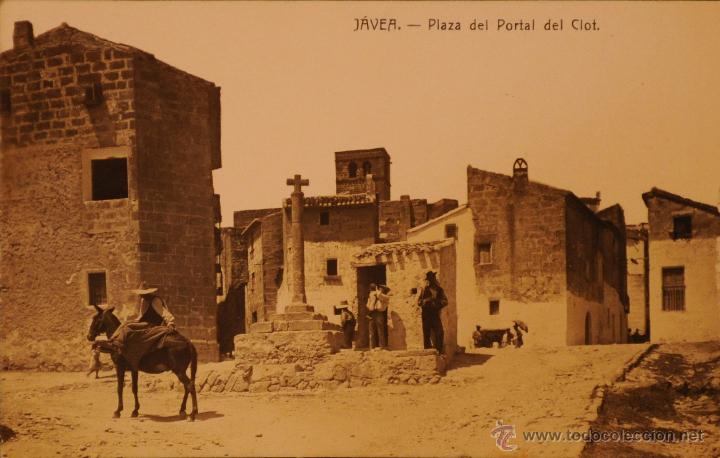In the past, settlers from many different cultures have inhabited and enjoyed this exclusive place. The name could very well come from the Arabic "Xibìa", meaning "abundant".
Xàbia or Jávea is a Valencian coastal town in the Marina Alta region (Alicante). It has always been a privileged and strategic place on the Mediterranean, attracting ancient Greeks, Romans, Arabs and Christians.* Report by Karla Ingleton Darocas, Hons. B.A. (KarlaDarocas.com)
Throughout the decades and the three great eras of prosperity and expansion, Xàbia has preserved some architectural and historical jewels. For students and art lovers, Xàbia is a great place to study art and architectural history with a focus on regional Mediterranean history and culture.
The most impressive building in this town today is the parish church of San Bartolomé.
It is a royal treasure, a jewel of Valencian Gothic / Isabelline architecture that combines exquisite aesthetics with military defensive elements such as a watchtower, a parapet on the roof and "murder holes".
For centuries, Xàbia was a coastal settlement that fell victim to many threats, attacks and raids by North Africans. To repel these attacks and protect its inhabitants, Xàbia developed a defensive-style town with strong stone walls, military watchtowers and a beautiful fortified church.
The most impressive building in this town today is the parish church of San Bartolomé.
It is a royal treasure, a jewel of Valencian Gothic / Isabelline architecture that combines exquisite aesthetics with military defensive elements such as a watchtower, a parapet on the roof and "murder holes".
For centuries, Xàbia was a coastal settlement that fell victim to many threats, attacks and raids by North Africans. To repel these attacks and protect its inhabitants, Xàbia developed a defensive-style town with strong stone walls, military watchtowers and a beautiful fortified church.
MEDIEVAL ERA - BRIEF HISTORY
As in the entire Valencian region, it was the mediaeval king of Aragon, Jaume I, who claimed Xàbia for the Christians in 1244 and set in motion the long and unsteady process of settling the city. The revolts of Al Azraq slowed down the process of repopulation.
It was not until 1397 that Xàbia received the title of village. By this time, the mediaeval village had grown into a network of narrow streets with a good defensive wall.
The layout would correspond to today's Roques, Ronda Sud, Sant Josep, Verge del Pilar, Pastores, Príncep d'Astúries and Ronda Nord streets.
It was not until 1397 that Xàbia received the title of village. By this time, the mediaeval village had grown into a network of narrow streets with a good defensive wall.
The layout would correspond to today's Roques, Ronda Sud, Sant Josep, Verge del Pilar, Pastores, Príncep d'Astúries and Ronda Nord streets.
Within this primitive city there was a defensive tower built on an earlier Arab tower called Torre d'Encairat. Near this tower, a primitive Christian church was built on the foundations of a conquered Arab farmhouse. Xàbia remained a tiny rural mediaeval outpost until the beginning of the 16th century, when the growth of the municipality meant that the walls had to be moved back to the new open roads.
PORTALS THROUGH THE FORTIFIED WALLS
The defective portals in and out of the village were called Portal del Clot (1554), Portal de la Mar (1561) and Portal de la Ferraria (1637).
Etymologically, the name "Clot" derives from the word Cros, which means the bottom of the town.

"Mar" means sea, so we can deduce that the door leads to the sea.
"Ferraria" is a reference to the cape of San Antonio. At the time of the Roman occupation, the cape was called the "Promontory of Ferraria", i.e. a high headland jutting out into a large body of water; a headland
Here, one of the first Christian orders from North Africa, led by Donato Servetian, founded a small community to escape persecution. It was called the Servitano Monastery. A Roman noble woman called Minicea, from the Valencia region, helped them to settle there.
TOSCA BUILDING MATERIAL
To support the new Christian growth, a building material called "Tosca" was introduced. It is a durable, honey-coloured sandstone that was quarried on the coast and in the caves by the sea.
This rock of calcareous origin formed thousands of years ago in the sand dunes and has been quarried in this region for several centuries. In the early 1970s, new environmental protection laws banned the quarrying of the sandstone.

The mediaeval fortress church of San Bartolomé was enlarged with Tosca stone blocks in 1513
This renovation work was paid for by the village's patrons, who had plenty of money thanks to their royal allegiance.
Bernardo de Sandoval (1502-1536) was the 2nd Marquis of Denia and uncle of Don Francisco Gómez de Sandoval, the first Duke of Lerma.
Sandoval married Francisca Enríquez y Luna, the cousin of King Ferdinand. This was a direct relation to the most famous queen of the Middle Ages, Isabel of Castile and her husband King Ferdinand of Aragon.
Both Sandoval and Enríquez each have a family coat of arms above the main portal of the church, decorated with wreaths of flowers to show their patronage.

REFORM AND BUILDER
Under the direction of the master builder Domingo de Urteaga, the fortress church was enlarged with a large Valencian-style Gothic nave and an apse with three chapels framed by buttresses on each side
Both the outer and inner chapels were decorated in honour of Queen Isabel with her chosen style of naturalistic flora, royal crowns, gargoyles, bay windows, pinnacles, ogee arches and heraldic shields of the patrons. The style was aptly named "Isabelline" architectural design.
* end *
Explore and Learn About the History of JÁVEA by visiting its exceptional architecture and monuments
*******
APPRECIATE ART & CULTURE * LOVE SPAIN
Resource Books written by
Karla Ingleton Darocas
and published by
SpainLifestyle.com
Resource Books written by
Karla Ingleton Darocas
and published by
SpainLifestyle.com
* CLICK HERE *
*******
*










